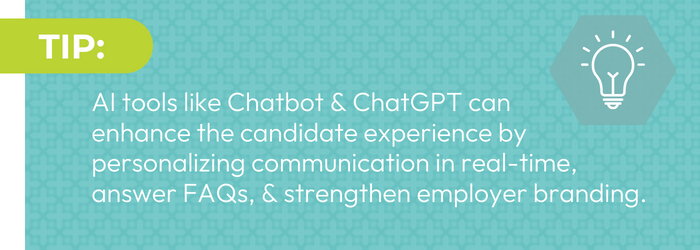→ Read here or access the instant PDF Download Available Here
Contents
- Understanding the Importance of Strategic Recruitment
- Set Strategic Recruitment Goals
- Become an Employer that Attracts Top Talent
- Maximize Marketing Strategies
- Invest for Recruitment Success
- Elevate the Candidate Experience
- Streamline Onboarding and Retention
Understanding the Importance of Strategic Recruitment
Strategic recruitment is not a mere administrative task but an endeavor that demands the expertise and involvement of all HR leaders. To build a strong workforce that drives innovation, productivity, and business growth, organizations must attract and hire high-quality talent.
What Is Strategic Recruitment?
Recruitment is the overall process of identifying and hiring candidates to fill an open job. Strategic recruitment, on the other hand, aligns recruitment efforts with the organization’s long-term goals and objectives. It is a forward-thinking and holistic approach to talent acquisition that involves implementing strategies to optimize resources and find the right candidates who can support the organization’s growth.
Why Strategic Recruitment is Critical for Organizational Success
Recruitment is far more than simply filling vacancies within an organization. It serves as the foundation upon which high-performing teams are built.
Effective recruitment has a direct impact on an organization's ability to achieve its goals and maintain a competitive advantage in the market. A robust recruitment strategy enables organizations to hire individuals who possess the right skills, experiences, and cultural fit to contribute to the collective success of the company.
However, an inadequate recruitment strategy can lead to profound adverse outcomes.
The Impact of Poor Recruitment Decisions on Business Outcomes
Poor recruitment decisions can lead to significant challenges and setbacks. Hiring individuals who lack the necessary qualifications or are not aligned with the organization's values can hinder productivity, disrupt team dynamics, and impede progress toward business goals.
How much does a bad hire cost you? According to the U.S. Department of Labor, the average cost of a bad hire is at least 30% of their annual salary.
In addition to this estimate, there are some other common expenses associated with a bad hire:
- Resources spent on recruiting and onboarding
- Time and costs associated with training
- Repeat recruitment costs to fill the position
The Role of HR Leaders in Driving Effective Recruitment
As strategic partners within organizations, HR leaders oversee the entire recruitment process. They work closely with other executives in the organization to ensure that recruitment objectives align with overall goals.
In addition, HR leaders have the crucial responsibility of implementing and driving effective recruitment strategies. This includes cultivating the employer brand, conducting interviews using best practices, and ensuring smooth onboarding processes. Their role also involves continuously elevating the recruitment process by utilizing innovative techniques and technology.
The key to successful recruitment is HR leaders who fully embrace their role in driving effective talent acquisition and are backed by a leadership team that understands the impact of recruitment on organizational success.
How to Set Strategic Recruitment Goals
HR leaders must set strategic recruitment goals that align with the overall business objectives and contribute to long-term growth. Strategic recruitment goals can shape a proactive and future-oriented recruitment strategy that attracts the right talent, fosters a high-performing workforce, and ensures the organization's goals are met.
Here's where to start:
Assess Current and Future Talent Needs
Understanding your organization’s talent needs is critical to building an effective recruitment strategy. Start by conducting an internal audit of your existing talent acquisition function and compare it to the organization's overall goals.
Identify Organizational Goals
To assess your talent needs accurately, collaborate with senior leadership and department heads to gain insights into the short-term and long-term objectives of the organization.
Identify the skills, competencies, and expertise required to achieve strategic goals, both presently and in the future.
Conduct a Gap Analysis
Conduct a skills gap analysis to identify any gaps between your current workforce and the skills needed to achieve business priorities. This audit will help you identify areas where you need to recruit new talent or upskill employees through training and development programs.
Analyze Workforce Demographics and Trends
Assessing your organization’s current workforce demographics and analyzing industry trends is vital for building a recruitment strategy that adapts to future needs. Evaluate the age distribution, diversity, and turnover rates within your workforce. This information can guide future planning.
Stay updated with industry trends, technological advancements, and changes in job market demands to help you identify potential skill shortages and emerging roles that will be crucial for your organization's growth. The Bureau of Labor Statistics can be a great resource to tap into when conducting research on labor demographics and trends.
Engage in Succession Planning
Succession planning is critical to ensure a seamless transition of key positions and maintain organizational continuity. Start by identifying critical positions within your organization and determine potential successors or high-potential employees who can step into those roles in the future.
Succession planning plays into the broader talent acquisition strategy because it can uncover any potential positions that may need to be filled in the future, allowing you to plan accordingly.
This can include training, mentoring, and professional development opportunities. Nurturing internal talent can reduce recruitment costs and retain valuable employees and institutional knowledge.
Set Strategic Recruitment Goals
Once you understand your organization's overall goals and objectives, you can set recruitment goals to drive the hiring process to support them. This alignment fosters a strategic approach to talent acquisition.
Define Recruitment Goals:
Recruitment goals should be set to guide recruitment efforts and achieve desired outcomes. These goals will vary depending on the unique needs of each organization but should serve as a roadmap for HR leaders and recruitment teams, providing focus and direction throughout the process.
Recruitment goals should follow the SMART framework: Specific, Measurable, Achievable, Relevant, and Time-bound. Here are a few examples of SMART recruitment goals that align with business objectives:
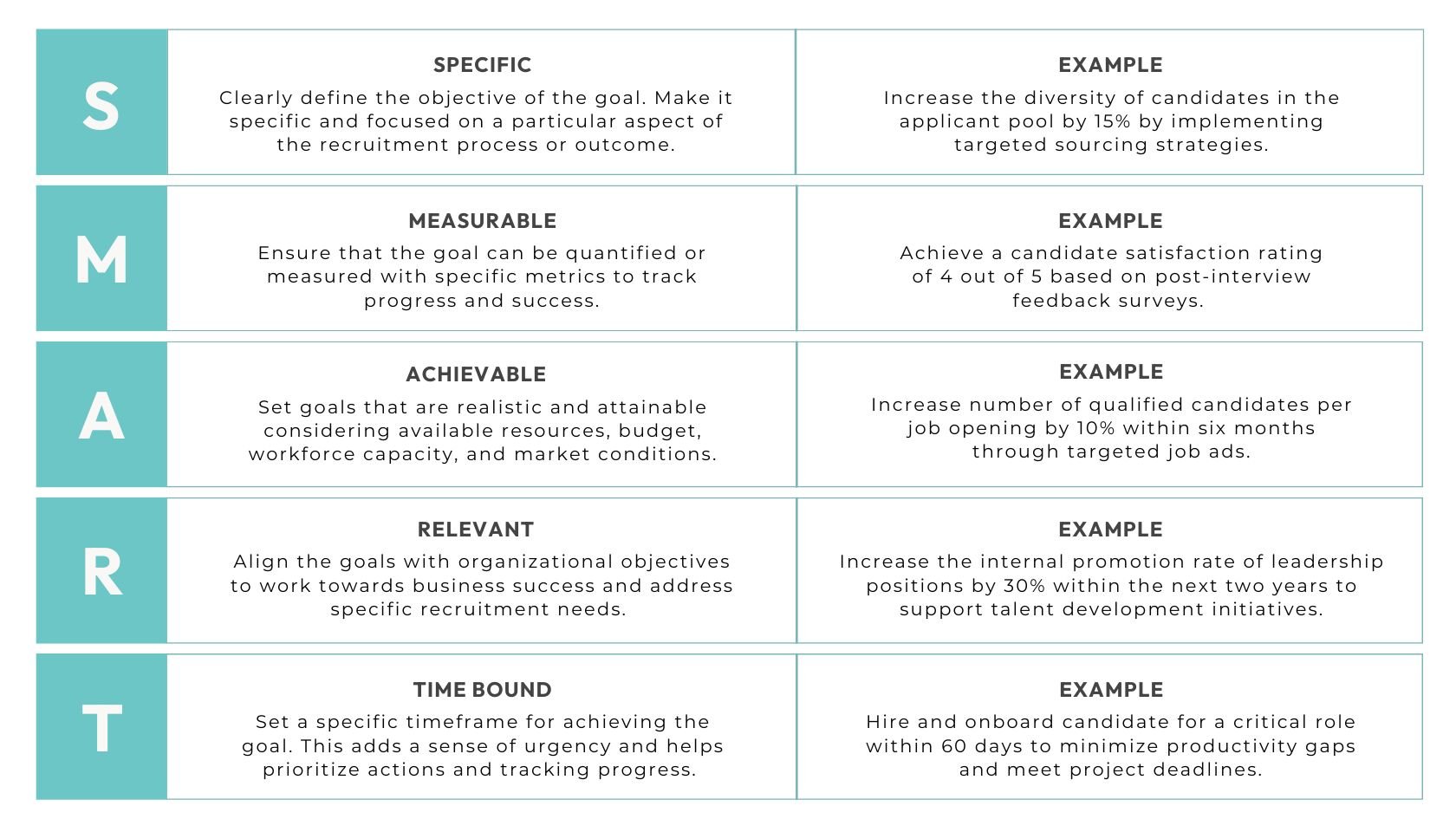
Track and Measure Recruitment Goals
Recruitment Key Performance Indicators (KPIs) are measurable metrics that you can use to track your recruitment efforts' success. The KPIs you choose to measure depend on your unique business and recruitment goals.
Here are some of the most common:
- Cost-per-hire: The total cost to fill an open position. This number should include all recruitment-related expenses such as marketing, advertising, and recruitment technology.
- Time-to-fill: The time it takes to fill a vacant position from the moment the job opening is posted to the day the candidate is hired.
- Source channel efficiency: Indicates the effectiveness of different recruitment channels such as job boards, social media, and employee referrals.
- Turnover rate: The percentage of employees who leave the company within a given period, such as the first three months, six months, or within the first year.
- Quality of hire: Measures the value a new hire brings to the company. This can be determined by considering the metrics above: hiring manager satisfaction, turnover and retention, and job performance.
How to Become an Employer that Attracts Top Talent
Review Employer Branding
Employer branding is a strategic effort aimed at attracting and retaining top talent by positioning the organization as an employer of choice. It refers to the perception and reputation of an organization based on employee experiences, company values, culture, mission, and work environment.
According to LinkedIn, a great employer brand can have a significant impact on a business's bottom line:
- 50% reduction in cost-per-hire
- 28% reduction in turnover
- 2x faster time to hire
A strong employer brand is particularly important in today’s competitive job market. 75% of job seekers consider an employer’s brand before even applying for the job, so this is your opportunity to create a compelling and favorable impression.
Position Your Company as an Employer of Choice
Demonstrating why your company is a desirable place to build a career can help create a compelling proposition for potential candidates. Leverage social media channels and your websites to highlight company values, culture, employee experiences, community involvement, awards, and unique perks.
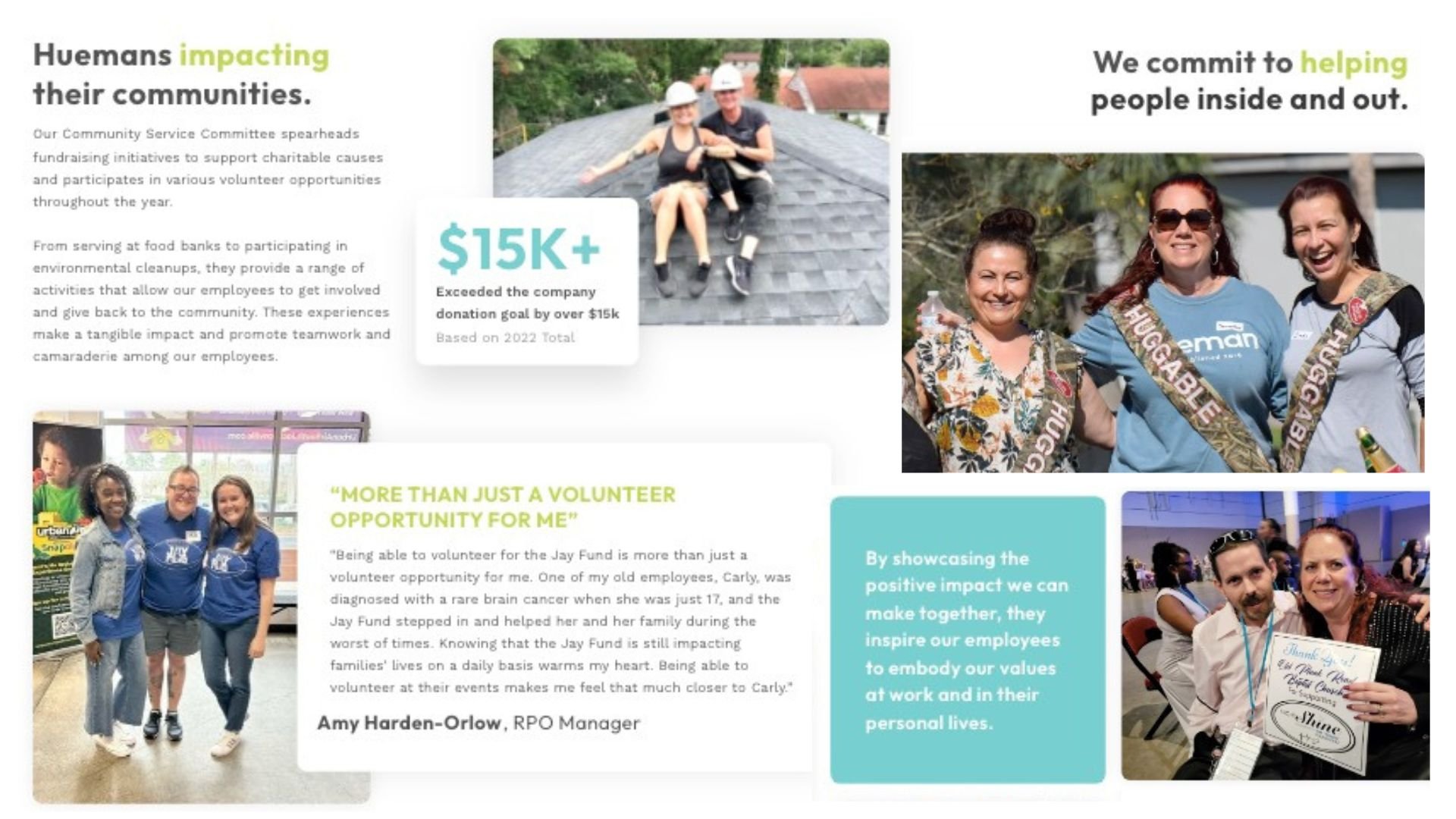
Encourage your team to regularly post updates, photos, and videos that reflect the experience candidates can expect. Existing employees can be a great tool to amplify your employer brand and framing the conversation from their point of view can provide authentic testaments of why your organization is a great workplace. For example, Hueman features testimonials from our employees who have organically become brand ambassadors that fuel our employer branding: 
Monitor the Narrative and Reputation of Your Company
It’s essential that your employer brand is aligned with the feedback and reviews your organization is receiving. Employer review sites, such as Glassdoor, can reveal valuable information about how your company is perceived.
Pay attention to the feedback and identify common themes or areas for improvement. External feedback can provide a broader perspective on your employer brand and help identify areas where adjustments may be necessary.
Companies with positive employer reviews get twice as many applicants as companies with negative reviews.
At a minimum, a good employer should have the following:
- Employer review website ratings above 3.5
- More than 20 online reviews
- Positive reviews showing on the first two pages
Benchmark Your Brand Against Competitors
Compare your employer brand against competitors and industry leaders. Research how other organizations in your industry position themselves as employers and assess their strategies. Use your findings to Identify areas where you can differentiate yourself and make improvements to stand out.
Regular evaluation and continuous improvement efforts will help you build a strong employer brand that attracts top talent, fosters employee engagement, and positions your organization as an employer of choice.
Are You Actually an Employer of Choice?
Making a promise of a positive work environment and an enjoyable experience is one thing, but is it true?
It's essential to ensure alignment between what you promote to job seekers and what you actually offer to avoid misrepresenting your company and misleading candidates. You can determine where your organization stands by conducting internal surveys and reviewing various aspects of your brand's offering.
Conduct Internal Surveys
Start by surveying your current employees to understand their experience with your company. Ask them about their level of satisfaction, understanding of the company’s values and culture, work-life balance, and overall experience working at your organization. This feedback can provide valuable insights into areas where improvements may be needed.
Evaluate Your Company Culture
Company culture is unique to each organization but can include values, mission, atmosphere, communication styles, and workplace norms. Ensure your organization has a clear vision and understanding of what you want your culture to be.
Evaluate your company culture by conducting observational assessments to review interactions, communication styles, work philosophies, and the overall atmosphere within the workplace.
Do your observations align with the desired culture of the company? Does your leadership team demonstrate the desired values and behaviors? The findings from this assessment can help you determine whether there needs to be any shifts that can strengthen your organization.
In addition to observational assessments, tracking performance metrics, turnover rates, and employee satisfaction scores can reveal patterns or trends that may indicate cultural issues.
Review Your Pay and Benefits Plan
Providing employees with a great culture is important, but compensation reigns supreme. Nowadays, there is an increasing demand for pay transparency and equity. When defining your compensation package, it is vital to ensure that it aligns with market standards.
Begin by conducting comprehensive market research to gain an understanding of the current state of similar positions and industries. This research should include information on base salaries, bonuses, incentives, and benefits.
Once you have this data, compare your compensation packages to industry standards and market rates to identify any possible disparities.
Offer Professional Development Opportunities
According to LinkedIn, 94% of employees say they would stay at a job longer if they were offered pathways for development.
Providing training or development programs that align with your target candidates' potential expectations is crucial. As an HR leader, you should want your workforce to reach their full potential and provide the resources to get them there. Review what other organizations in your industry offer, such as training, mentorship, and career development programs to identify any opportunities you may be missing.
Here are a few employee development methods to consider:
- Coaching and mentoring programs
- Cross-training to broaden skill set beyond their day-to-day roles
- Job shadowing to learn about other departments and roles
- Online courses and certifications
Career mapping is another great way to help employees get where they want to be in their professional growth. It shows employees that you have a clear path for their career growth within the company and will be supported with resources to get there.
If you have established programs, highlight these opportunities across your employer branding. One way you can do this is by featuring employee success stories to showcase career growth and skill development within your organization.
Build an Employee Value Proposition (EVP)
Once you’ve assessed what your company offers to an employee and what sets you apart from competitors, it’s time to update or build your Employer Value Proposition.
An EVP represents an organization's value and advantages to its employees, distinguishing it as an employer of choice.
Your EVP should be a clear, concise, and authentic statement that highlights the unique selling points of your organization, such as compensation, benefits, career development opportunities, and other perks like flexibility and remote work.
Ask yourself why candidates would want to work for you – is it the culture? Innovation? Mission?
Involve key stakeholders in the process of crafting your EVP. Seek their input, validate the messaging, and ensure the EVP accurately reflects what your company has to offer.
Here are a few examples of EVPs:
- Hueman RPO: At Hueman, we invest in a positive culture of engagement, development, and inclusivity because we believe that everybody is somebody.
- Airbnb: “Create a world where anyone can belong anywhere.”
- Nike: “Win as a team.”
- EY: Whenever you join, however long you stay, the exceptional EY experience lasts a lifetime.
Key Investments for Recruitment Success
Investing in the right people is crucial for the success of your business. Therefore, it stands to reason that finding ideal candidates will yield positive returns. In the following section, we will discuss the significant areas you should focus on to attract, hire, and retain top talent for your organization.
Technology
Recruitment is a dynamic and ever-evolving field, and technology plays a vital role in streamlining and optimizing the process.
The right recruitment technology can act as a fully integrated ecosystem customized to meet your needs. From candidate sourcing and engagement to recruiter workflows, technology can support every step of the process. With a tech-enabled recruiting function, you can strengthen and optimize your team's performance.
Let's look at some tools you might have in your organization's tech stack or might be considering.
Applicant Tracking Systems (ATS)
An ATS is a powerful tool that automates and centralizes the entire hiring process, from job posting to candidate onboarding.
While many organizations already have an ATS, it’s not often they maximize the system to its full potential. Let’s review a few ways you can optimize your ATS to better integrate with your talent acquisition process:
- Enhance the interface: Adjust the application form to eliminate unnecessary fields and simplify the application submission process to ensure it is intuitive.
- Tailor Your Configuration: Tailor your ATS configurations to ensure the proper structure of regions, divisions, facilities, communication templates, and workflows.
- Optimize reporting capabilities: Utilize your ATS to generate and track valuable insights such as time-to-fill, source of hire, and candidate conversion rates.
- Streamline your workflows: Eliminate unnecessary steps, automate repetitive tasks, and ensure seamless integration with other HR systems to improve workflow efficiency.
- Integrate with other channels: Most systems can integrate with various recruitment channels, including job boards, social media, and career websites. This enables a seamless distribution of job postings and centralized candidate management.
- Train Your Team: It is critical to ensure your team is well-versed in utilizing all the features and functionalities of your ATS to maximize its potential. Provide comprehensive training and ongoing support to those who work with the system.
Data Analytics & Reporting Tools
Data-driven recruitment is becoming increasingly important for making informed decisions. Investing in data analytics and reporting tools enables HR leaders to measure and analyze key recruitment metrics.
Tools such as Google Data Studio and Microsoft Power BI can provide insights into sourcing channels, candidate quality, time-to-fill, and cost-per-hire. They produce interactive dashboards using real-time data to show the progress of the recruitment process in a visual manner.
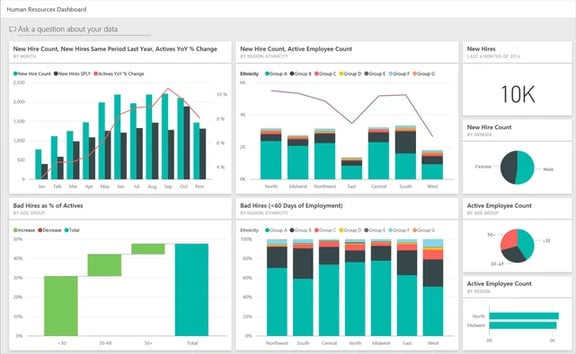
By leveraging data analytics, leaders can identify bottlenecks, optimize processes, and refine recruitment strategies for better outcomes.
Recruitment Assistant Technology
Recruitment technology can aid in streamlining administrative tasks, reducing time consumption, and increasing efficiency throughout the recruitment process. Implementing these tools decreases the time recruiters spend on repetitive tasks and allows them to become more efficient, reducing time to fill.
This technology can provide a wide range of capabilities, including automated chatbot support, text engagement, interview scheduling and reminders, and even onboarding document sending while maintaining industry-standard security.
Here are a few examples of companies that offer recruitment assistant technology solutions:
- HiredScore: Leverages the power of bias-free AI to deliver deep hiring efficiencies, enhance talent mobility, and help enable data-driven human resources. This allows you to evaluate and prioritize candidates more effectively and efficiently, giving every candidate a fair review and allowing rejected candidates to show up for relevant roles in the future.
- Ideal: An AI-powered talent screening and matching system that helps recruiters make more accurate, fair, and efficient talent decisions. This technology allows you to screen and shortlist thousands of candidates in real-time and scrub existing applicant databases for top candidates.
- HR Avatar/Criteria: Provides simulation-focused assessments and gamification options. These technologies all integrate with most ATS platforms on the market and can provide a lot of value when the assessment data and information are used to screen or help with the selection process.
Candidate Screening and Assessment Technology
HR leaders can improve the accuracy of candidate evaluation and increase the likelihood of finding the best-fit candidates for their organization by leveraging different assessments and technology:
- Pre-employment assessments: These assessments help your team evaluate candidate skills, cognitive abilities, and personality traits to benchmark and compare candidates objectively.
- Reference Checking Software: These technology-driven tools can automate the reference verification process, allowing HR leaders to gather feedback from previous employers efficiently.
- AI-powered Screening Tools: These tools can help recruiters narrow down the candidate pool by using AI technology to analyze resumes, cover letters, and application responses to identify relevant skills, experience, and qualifications.
Below are some screening tools and assessments to consider:
Though technology can create efficiencies, it is crucial to note that there is a potential for biases to emerge. These biases can manifest in various ways, such as scanning résumés for specific keywords or relying on facial recognition patterns in video interviews.
Technology should not replace human effort but rather serve as a tool to enhance human capabilities and improve the overall quality of decision-making.
Recruiter Training & Specialization
Training Programs
Investing in training programs equips your team with the necessary knowledge and skills to excel in recruitment. Training programs can ensure your recruiters are consistent, efficient, and inclusive throughout the process.
Trained recruiters ask better questions and can identify stronger candidates that will align with your business goals. Plus, they understand the importance of clear communication, timely feedback, and personalized engagement, which can lead to a smoother candidate journey.
DEI Certifications
HR leaders can provide opportunities for their recruiters to become Diversity, Equity, and Inclusion Certified. Though the process varies by program, most consist of specific coursework or training modules focused on DEI principles, unconscious bias awareness, inclusive recruitment strategies, and creating inclusive job descriptions and interview processes.
DEI-certified recruiters are crucial in supporting organizations' diversity and inclusion initiatives. They actively seek out diverse talent, leverage inclusive sourcing strategies, and implement equitable selection practices to ensure fair representation throughout the recruitment process.
Specialized Recruitment Expertise
Certain roles and industries require specialized knowledge and understanding to identify and attract suitable candidates. Technical recruiters, in particular, possess deep industry knowledge, understand the intricacies of niche roles, and have established networks within those sectors.
This expertise enables them to identify top talent, assess candidates accurately, and speak the language of the industry, enhancing the quality of hires.
How to Maximize Recruitment Marketing Efforts
Leveraging recruitment marketing enables you to match the fast-paced demands of the digital world in which your ideal candidates live while providing a great candidate experience.
A strategic and well-funded marketing approach can improve the ROI of your recruitment efforts by attracting a higher volume of qualified candidates and reducing time-to-fill.
Create or Update Your Candidate Personas
A strong candidate persona is vital to understanding your ideal candidate, their goals and motivations, and the qualities that make them the perfect fit for your organization. Your persona is the roadmap for who you need to attract and can aid in:
- Marketing efforts: Marketing opportunities expand significantly when you know more about your ideal candidate. You can target ads based on personal motivators or attributes (like hobbies), expanding beyond the common demographic selections.
- Interviewing: Candidate personas allow you to customize interview questions for each role – helping you provide a personalized experience.
- Career pathing: Understanding their unique motivators can help you create the right career path and increase retention.
It's important to review your candidate personas for each position to ensure they accurately depict your ideal candidate and are up to date.
Write SEO-Optimized and Inclusive Job Descriptions
An effective job description can attract the right candidates, set expectations for a role, and ensure a more efficient hiring process. However, poorly written job descriptions can deter qualified candidates and result in a bad hire.
Make sure your team is developing job descriptions that are:
- Inclusive: Avoid using any language that may be biased or exclusive.
- SEO-Optimized: improve the visibility of your job postings and increase the quality and quantity of website traffic.
- Clear, concise, and include critical job and company information such as location, work hours, pay, and benefits.
Advertise Your Jobs
Online job advertising provides access to a vast pool of potential candidates, allowing your organization to reach a broader audience beyond traditional methods. Digital marketing allows you to target specific qualifications, experience, and other attributes you’re looking for so your jobs reach the right candidates, which can save you time and money.
Additionally, online job sites offer insights into how your job posts are performing and which platforms are the most effective, allowing you to optimize efforts for better results.
Enhance Your Career Website
A robust career page will assist you in organically attracting the most qualified people without investing in additional resources.
Successful career websites require regular maintenance because of the ever-changing digital landscape. Conduct semi-annual audits to assess whether your career website follows marketing best practices for SEO, conversion optimization, engagement, and advertising success.
Review your website to ensure you have clear navigation, relevant content, and compelling visuals to help candidates explore job opportunities and learn more about your company.
Diversify your Marketing Mix
To increase the number of applicants for your open positions, utilizing various marketing mediums is crucial. Tap into all available resources to maximize your efforts and reach a larger audience. Here are a few mediums to explore:
- Email Marketing: Contact previously qualified job applicants from your ATS. Only email those from the past two years to help the health of your email list.
- Job Board Advertising: Consider investing in LinkedIn, Indeed, and ZipRecruiter licenses to maximize the exposure of your job postings and target ideal candidates.
- Social Media: Career-specific pages can help candidates find links to jobs, updates on company culture, press, and more.
- Text Messaging: Schedule mass texting campaigns to market your job openings. TextRecruit is a platform our recruiters use.
- AI/Chatbot functionality: Guide job seekers through the career site and answer questions in real-time.
- Direct outreach: Leverage connections on platforms such as LinkedIn or networking events. Discuss mutual interests, connections, or sell open positions and company culture.
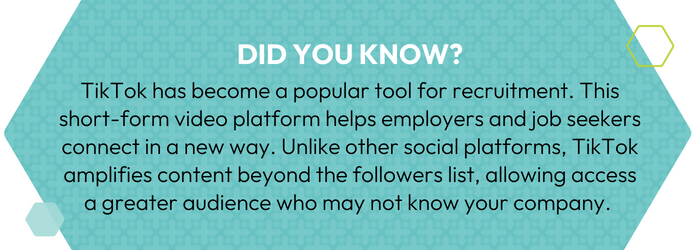
How to Nurture a Positive Candidate Experience
The candidate experience can significantly impact the success of a business. A positive experience can help develop a favorable perception of a company, which can extend to products or services, leading to business growth and revenue generation.
Benefits of a positive candidate experience
Saves Time and Resources
A positive candidate experience can increase the number of qualified candidates applying for positions, shorten the time it takes to fill vacancies and decrease candidate drop-off rates. These enhancements ultimately result in a more efficient and effective recruitment process and cost savings.
Attracts Talent & Candidate Referrals
From the moment a candidate interacts with your organization, whether through the job application process, interviews, or communication, they form an impression of your company. A positive candidate experience leaves a lasting impact and can significantly influence a candidate's perception of your organization, both as a potential employer and as a brand.
Candidates who have had a positive experience are more likely to become brand advocates and share their stories with their networks through online reviews, social media, or word-of-mouth, helping to build a favorable reputation. These employee referrals are a valuable source of high-quality candidates, often resulting in faster hiring cycles, lower recruitment costs, and improved retention rates.
Impacts Revenue
A negative candidate experience doesn’t just deter potential employees; it can also cost you future business. Candidates who have poor experiences may form negative perceptions about the organization. Their negative sentiment can quickly spread in today’s digital world, impacting customer satisfaction, loyalty, and, ultimately, your organization's bottom line.
How to Elevate Your Candidate Experience
A significant factor that impacts applicant flow is the apply process. Effective application processes are supported by modern, mobile-friendly technology substantiated by a strong employer brand.
To ensure your organization provides a positive candidate experience, have your team go through your application process. While doing so, here are a few things to keep in mind:
Create a Streamlined and Candidate-Centric Application Process
Ensuring your application experience is as streamlined and effortless as possible is key. A good application process can reduce drop-off rates and ensure top candidates follow through with applying to your position.

To determine if an organization has an efficient application process, it should be able to answer "yes" to the following questions:
- Is your careers section easy to find on your website?
- Is your job search function easy to use?
- Does your job search function have filtering options?
- Do you clearly communicate critical information about your company and the position?
- Are your job descriptions compelling, clear, and inclusive?
- Is your application mobile-friendly?
- Does your application have less than 30 clicks?
How to Optimize the Interview Process
A streamlined interview process is a critical component of a positive experience and hiring top candidates. In fact, 83% of talent say a negative interview experience can change their mind about a role or company they once liked. Here are a few ways you can enhance your process:
- Training and resources: Equip your team with the necessary training tools and resources to conduct effective, consistent, and inclusive interviews. A trained interviewer can hire better candidates and provide a positive experience.
- Interview stages: Though interview stages vary greatly depending on the type of position, you should ensure the process and steps are consistent from candidate to candidate. These are the standard stages: phone screening, assessments, in-person interviews, group interviews, and presentations/assignments.
- Interview process length: According to LinkedIn, the ideal interview process length is between three to six weeks. An efficient interview allows you to learn as much about the candidate as possible while respecting their time. Establish a schedule and agenda to ensure consistent interview lengths and try to avoid a prolonged period in between each stage.
How to Ensure Timely and Meaningful Communication Throughout the Process
Personalized communication
A positive candidate experience includes personalized communication with candidates at each stage of the hiring process. Leveraging marketing automation tools can help you send tailored emails, SMS, and messages throughout the process to share relevant updates and promptly address inquiries. Personalized communication shows that your organization cares and values each candidate at every step of the hiring process.
Maintaining Candidate Momentum
The timeliness of your feedback and communication is another critical component of a positive candidate experience. Prompt communication is essential to keeping top talent engaged, especially in a competitive labor market.
Additionally, delayed feedback can leave candidates feeling uncertain and disengaged. Even if a candidate is not moving forward, providing a timely response shows respect for their time and effort.
Communicating to Candidates Who Didn’t Get the Job
Every candidate is an opportunity to build relationships and your talent pool. End on a good note by expressing gratitude for their participation and encouraging them to apply for future opportunities if appropriate.
Provide specific examples and detailed observations from their interactions or assessments so they understand their strengths and areas where they can grow skills while maintaining a positive note. This helps candidates gain closure while maintaining a positive impression of your organization.
Have you heard of “Ghosting”? Ghosting is when a candidate or recruiter abruptly cuts off contact and becomes unresponsive to emails or phone calls during the recruitment process. While it is more commonly associated with job seekers, it's important to ensure your recruiters avoid this practice as it can damage your reputation and candidate experience.
Promptly responding to inquiries, being transparent about timelines, and treating candidates with respect can help reduce the likelihood of candidate ghosting and ensure a positive experience.
Communication is a Two-Way Street
Feedback is a critical component of an enhanced candidate experience. Fostering an environment of open communication with candidates will help you collect candid feedback about your process. Use this valuable information to enhance your interview practices and strengthen your employer brand.
Onboarding and Retention Strategies
Onboarding new employees should be a strategic process that sets the foundation for long-term employee success. As leaders, it is critical to understand the impact your onboarding process can have on the company’s bottom line.
69% of employees are more likely to stay with a company for three years if they experienced great onboarding -OC Tanner
Implementing a structured and well-designed onboarding process has proven ROI and can create positive work environments, boost employee satisfaction, and reduce turnover rates. Put simply, a successful onboarding process protects your new hire investment.
How to Develop a Comprehensive Onboarding Program
Align Your Onboarding Team
Part of a successful onboarding process is to ensure collaboration between key stakeholders. As an HR leader, you are responsible for ensuring they know their roles in the process and holding them accountable to provide a consistent and seamless experience.
Below are the key stakeholders in the onboarding process, along with their typical responsibilities:
- Recruiters: Pass new hires to human resources to begin the onboarding process.
- HR team: Provides information and tools to transition new hires into permanent employees. They also ensure that new hires have completed all necessary documentation and comply with legal requirements.
- IT/Facilities: In charge of setting up necessary equipment and software for new hires. Provides details on building access, parking, or other physical access requirements.
- Hiring manager: Responsible for acclimating new hires into their specific roles and teams. This involves setting goals and identifying strategies to drive productivity.
Ensure Your Process is Streamlined and Optimal
The first week for a new employee should be exciting and welcoming. To achieve this, it is vital to confirm that all necessary documentation and resources are streamlined and organized ahead of their first day on the job.
Here are a few items to provide and keep in mind during the process:
- Provide online access to review and sign documentation prior to the first day
- Ensure resources are provided timely for a work-ready set up (laptops, desk, software, etc.)
- Follow an agenda to help stick to a schedule and avoid missing critical information
- Keep your EVP top of mind throughout your onboarding process
Include Critical Subject Matter
There are a range of topics and information you can discuss during the onboarding process. To strike a balance between informative and overwhelming, stick to these key topics:
- Organizational overview: Provide information about your company, including history, mission, values, and strategic goals. This is also the time to outline the company structure and organizational chart – take the time to explain how their roles play into the broader goals of the company.
- Company history: Take your new hires on a journey to where it all started. Share interesting facts, photos, or any other content that paints a full picture of how your company came to be.
- Culture and values: Immerse your new hires in the company’s values by sharing stories and examples that exemplify the culture and provide a sense of the desired behaviors and norms.
- Stakeholder introductions: Explain the organizational chart of the company by using visuals and headshots to familiarize new hires with leaders. At Hueman, we set up meetings with a group of new hires and our executives so they can explain their roles while getting to know each new hire. We encourage everyone to share a fun fact about themselves to facilitate connections and organic interactions.
- Policies and procedures: introduce the employees to essential guidelines and handbooks such as code of conduct, ethics, dress code, work hours, and attendance policies. Make sure to mention any health and safety procedures so the employee knows how to maintain a safe work environment.
- Technology & systems: Familiarize the employee with the organization's technology systems, software, and tools they will use. Provide training on email systems, messaging channels, intranet platforms, project management tools, and other relevant software to ensure they can navigate and utilize them effectively.
- Benefits: Walk your new hires through the company benefits and compensation packages in detail, including healthcare plans, retirement savings, paid time off, and other relevant perks. Highlight members of your company who can help set up these benefits.
- Development opportunities: Outline available training and development opportunities, including internal or external programs, workshops, conferences, educational opportunities, and certifications.
How Long Should Onboarding Last?
Integrating a new employee into their team and the broader organization should be an ongoing effort. While the length of the onboarding process can vary depending on industry and roles, SHRM recommends at least one year to ensure high retention.
Regular check-ins and ongoing communication throughout the employee's first year are crucial. Leverage surveys or pulse reports to gauge their progress, ensure they have adequate resources to do their job, and allow them to raise concerns. These actions show employees that your organization genuinely cares about them, which could ultimately influence their decision to remain with the organization or depart.
Embracing innovative approaches and adopting a strategic mindset can help leaders elevate recruitment efforts to drive the long-term success of the organization.
If you’re looking for a partner to help implement effective recruitment strategies, we’re here to help.









